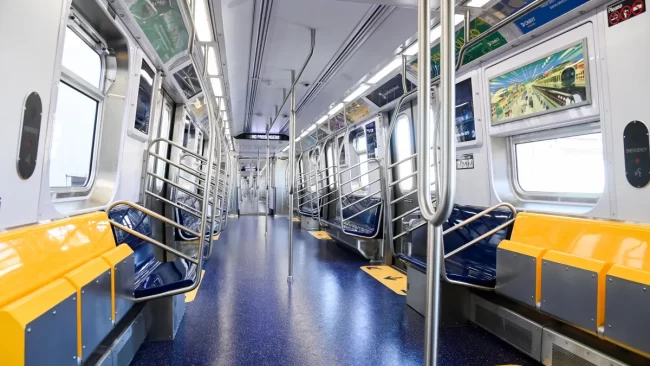If you happen to find yourself waiting for a “C” train, you might notice a particularly new-looking subway train. You might first take in the sleek exterior, digital screens or the unfamiliar “R211” on the car, but their true strength lies in the interior. Called “open-gangway” trains, these subway cars have no doors between them; rather, the entire train comprises a singular long car. Instead of typical joints with doors, these trains have accordion joints that allow for open, smooth movement between cars.
The Metropolitan Transportation Authority (MTA) debuted three versions of the new R211 train: R211S, which replaced many cars on the Staten Island Railway; R211A, which can be seen on the “A” trains; and R211T, the only version of the three to feature the open-gangway design. While the R211T trains may be the most exciting, they are also very few in number. Of the around 535 R211 cars built, a mere 20 cars (2 full trains) are open-gangway. The MTA said 437 more open-gangway cars could be delivered next year.
There are many potential benefits: for example, the doors are wider, allowing passengers who use wheelchairs or strollers to more easily enter and exit the train. In addition, the lack of space between cars deters the dangerous habit of “subway surfing,” the name given to riding between or on top of train cars. Passengers also noted the more modern screens; each car has 28 digital displays including the typical designs near the top of the car and the larger designs on the walls.
Designers of the new R211 trains chose to make the walls a white to make the car feel more spacious and made the seats a dark blue to disguise dirt and grime. Because people feel more at ease in brighter environments, the MTA ditched their usual fluorescent bulbs in favor of LEDs, which last longer and are more energy-efficient, and installed the lights at an angle to brighten the entire car. Red warning lights are installed near the doors to warn passengers when the doors are closing.
Instead of worrying about which car is the most crowded or has the most comfortable air conditioning, passengers simply enter through any door and from there, they can easily move around. New York Governor Kathy Hochul noted, “[the open-gangway design] allows people to make that decision on your own, you’re not trapped and confined and conscribed to your first decision, you have more options. So I think psychologically, it just improves the experience for the riders overall.”
While the R211T trains have many benefits, they have a major problem: they cannot run on express tracks. The reason for this issue is due to safety protocol, which requires train operators to inspect both sides of the track. When the operator cannot walk along the tracks safely, they must climb in between the cars to perform the inspection.This kind of inspection is easily done on the typical trains, but without openings between cars, operators cannot reach between cars. For now, the trains will continue running solely on the “C” line, where it is safe to do so.
The design is similar to pre-existing European designs, such as that of the Paris Metro or London Tube. According to Governor Hochul, the R211T trains are the first open-gangway trains in revenue service in North America. Underground train systems in the U.S. have previously resisted the change to open-gangway junctions. The MTA’s decision to employ these newer trains could signal the start of a country-wide shift in train design.
For Fieldston students, the new cars could improve the ride for those who live in Brooklyn or Queens or those who frequently commute there. A Form III student said “It’s an exciting new change because it makes the subway more streamlined.” Even if you don’t ride the “C” train often, it might be worth a trip to see the new subway trains in action.






